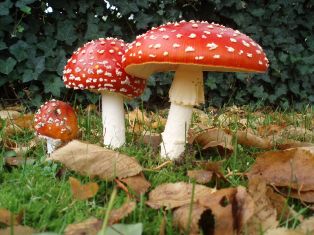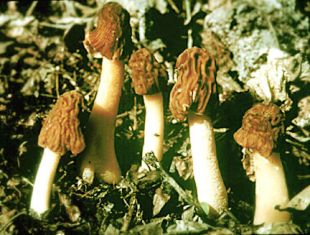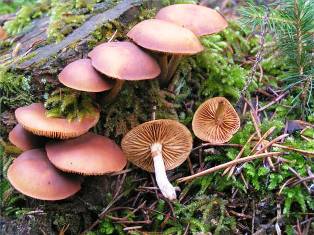Discover Florida Nature
It's time to explore the natural Florida


|
|
|
|
|
|
The state of Florida is host to many species of flora and fauna.
Wildlife abounds throughout the state and with the high level of
moisture coming from the rains that saturate Florida for many months of
the year, mushrooms in many varieties dot the landscape. While many
types are highly toxic, there are also a good number that are edible.
Mushrooms , Toadstools and the Yeast that is used to make bread are all different kinds of fungi. Although some fungi grow in the ground , they are not plants because they cannot make their own food. Fungi play a very important roll in nature. They break down dead plant and animal matter so that the base chemicals of which the dead plants and animals were made of can be used again. Fungus Spores are every where. If they land where there is warmth and nutrients the fungi will develop and grow. Mushrooms and Toadstools are the fruiting bodies of various forms of fungi. The fruiting bodies usually form in autumn but the fungi are in the soil the rest of the year. They grow in damp fields and dark woods and they do not need sunlight to grow. During the midsummer rain, mushrooms popped up in many lawns. But even if you can't see them, the fungi still are there. Some fungi feed off decomposing matter, such as mulch. Others will rot wood structures or kill a palm tree. A shelf-like conk may form on the trunk of a palm, and it's bad news with an ugly name: Ganoderma butt rot. "Once you see that, the palm will die," said Sally Scalera, University of Florida horticulture extension agent for Brevard County. "You can't plant any other palm in that spot, because the fungus will live in the soil. And if it's close enough to another palm or the roots can grow together, it'll move from one palm to the other. And it's spread by spores. So if there's any wound in the palm trunk from weedeaters or nails or whatever, that's always an opening that the spore can go into." Wild mushrooms grow best in wet areas. In Florida, mushrooms usually grow in warm weather, after a rain. Therefore, most cases of mushroom poisoning happen from June through October. Florida has several thousand types of mushrooms. They grow all over the state, especially in wooded areas. Fans of fungi become enamored of their delicate forms and colors, and going into the back yard after a rain can turn into a revealing safari.  Some
mushrooms, such as the ones pictured here, produce toxins, or poisons,
which can make humans and animals sick. One mushroom can produce more
than one type of toxin. Farm sprays can contaminate wild mushrooms that
may also make you sick, even if the mushroom is safe to eat. Anyone can
get sick from eating mushrooms. The Florida Poison Information Center
Network receives hundreds of calls each year related to suspected
mushroom poisoning. Most people experience symptoms such as nausea,
vomiting, stomach cramps, and diarrhea. However, in a few cases,
symptoms are much worse and include rapid heart beat, agitation, and
hallucinations. Over half of these calls involve children less than six
years of age. Some
mushrooms, such as the ones pictured here, produce toxins, or poisons,
which can make humans and animals sick. One mushroom can produce more
than one type of toxin. Farm sprays can contaminate wild mushrooms that
may also make you sick, even if the mushroom is safe to eat. Anyone can
get sick from eating mushrooms. The Florida Poison Information Center
Network receives hundreds of calls each year related to suspected
mushroom poisoning. Most people experience symptoms such as nausea,
vomiting, stomach cramps, and diarrhea. However, in a few cases,
symptoms are much worse and include rapid heart beat, agitation, and
hallucinations. Over half of these calls involve children less than six
years of age. There
are many myths and tales about what mushrooms are safe to eat. However,
there is NO easy, clear way to tell if a wild mushroom is safe or
poisonous. There are thousands of types of mushrooms and about 100 that
are known to be poisonous. Many poisonous mushrooms look like mushrooms
that are safe to eat. Poisonous mushrooms may grow beside good
mushrooms. The best way to tell if a mushroom is safe to eat is to have
it identified by an expert (mycologist) or to buy it from a store or
restaurant. Poisonous mushrooms cannot be made safe to eat by cooking,
freezing, washing, or canning. The only way to prevent mushroom
poisoning is to avoid eating toxic mushrooms. There
are many myths and tales about what mushrooms are safe to eat. However,
there is NO easy, clear way to tell if a wild mushroom is safe or
poisonous. There are thousands of types of mushrooms and about 100 that
are known to be poisonous. Many poisonous mushrooms look like mushrooms
that are safe to eat. Poisonous mushrooms may grow beside good
mushrooms. The best way to tell if a mushroom is safe to eat is to have
it identified by an expert (mycologist) or to buy it from a store or
restaurant. Poisonous mushrooms cannot be made safe to eat by cooking,
freezing, washing, or canning. The only way to prevent mushroom
poisoning is to avoid eating toxic mushrooms. There
are many different signs of
mushroom poisoning. The
toxins in some mushrooms can cause your stomach to be upset, damage your
brain or nervous system, hurt your liver or kidneys, and cause death.
Some toxins may have unknown, long-term effects that may cause cancer.
Signs of mushroom poisoning can include: diarrhea, upset stomach,
vomiting, stomach, cramps, chills, fever, headache, weakness,
drowsiness, dizziness, sweating, drooling, confusion, muscle spasm, and
hallucination. These signs may vary depending on the amount of toxin in
the mushroom and the amount of mushroom that you eat. Some people may
get sick immediately and some may take several hours to show signs of
poisoning. There
are many different signs of
mushroom poisoning. The
toxins in some mushrooms can cause your stomach to be upset, damage your
brain or nervous system, hurt your liver or kidneys, and cause death.
Some toxins may have unknown, long-term effects that may cause cancer.
Signs of mushroom poisoning can include: diarrhea, upset stomach,
vomiting, stomach, cramps, chills, fever, headache, weakness,
drowsiness, dizziness, sweating, drooling, confusion, muscle spasm, and
hallucination. These signs may vary depending on the amount of toxin in
the mushroom and the amount of mushroom that you eat. Some people may
get sick immediately and some may take several hours to show signs of
poisoning. |
|
|
Advertise | Privacy Statement | Dog Encyclopedia | Video |Contact | Alaska Nature |
|